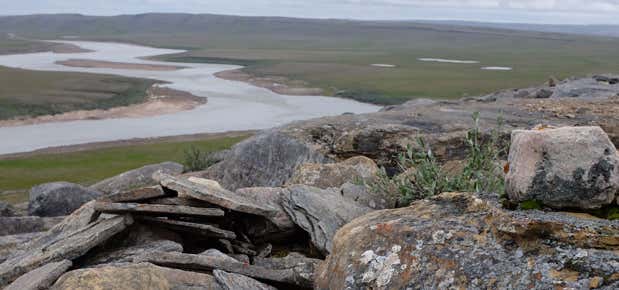“one of Canada's undiscovered gems”
With rolling tundra, wild rivers, precipitous canyons, and a variety of unique wildlife and vegetation, Tuktut Nogait (‘young caribou’) is one of Canada’s undiscovered gems. This remote park is located 170 kilometres north of the arctic circle and is home to the Bluenose West caribou herd, wolves, grizzly bears, muskoxen, arctic char, and a high density of raptors. The wildlife and land have supported aboriginal peoples for thousands of years, from the Copper and Thule cultures to contemporary Inuvialuit. Tuktut Nogait National Park is a national park located in the Northwest Territories of Canada. Meaning "young caribou" in Inuvialuktun, the park is home to the calving grounds of the Bluenose-West caribou herd. However, it is also the home to other wildlife species, such as Muskox, Grizzly Bears, Arctic char, and the Grey Wolf. Tuktut Nogait is also a major breeding and nesting ground for a wide variety of migratory birds. Raptors such as Peregrine Falcons, Rough-legged Hawks, Gyr Falcons and Golden Eagles nest along the steep walls of river canyons. The main rivers that run through the park include the Hornaday River, Brock River and Roscoe River. The park encompasses over 18,000 square kilometres (6,900 sq mi) and is located 170 kilometres north of the Arctic Circle in the northeast corner of mainland Northwest Territories. Humans have occupied Tuktut Nogait since AD 1000 and recent surveys have identified over 360 archaeological sites in the park. The oldest known archaeological sites are most likely Thule or Copper Inuit ranging from AD 1200 to 1500. Father Émile Petitot was the first European to reach the area in 1867-68. In 1930, the Hudson's Bay Company established an outpost at Letty Harbour but the post was closed in 1937 due to insufficient trade. In 1935, a Roman Catholic Mission was located at Paulatuk and operated a small trading post there until 1954. The Inuit who came to Paulatuk and the Darnley Bay area were primarily Mackenzie and Alaskan Inuit from the west. In 1955, most people abandoned the Paulatuk mission and moved to Cape Parry where a Distant Early Warning (DEW) line site was being built, which meant seasonal construction and permanent wage labour work. As is outlined in the Inuvialuit Final Agreement and the Tuktut Nogait Agreement, Inuvialuit beneficiaries have the right to pursue subsistence harvesting within the park. Currently, this takes place in the north-western part of the park and mostly entails fishing Arctic char, hunting caribou, and some trapping. By federal national parks legislation, commercial or sport hunting is not permitted. Current park initiatives include establishing a base camp facility at Uyarsivik Lake to support ecological integrity and cultural resource monitoring, visitor opportunities, management meetings and youth outreach; developing a cultural resource strategy; and updating interpretive materials such as the Hornaday River guide.
Reviews
Be the first to add a review to the Tuktut Nogait National Park.
/-123.01615,69.28333,14/300x172@2x?access_token=pk.eyJ1Ijoicm9hZHRyaXBwZXJzIiwiYSI6ImNsdjQ5N2VtZDA2bW8ycW13ZHAxeGhjbjkifQ.UIccpoAxc7g3BAuK4s9vjg)
Tuktut Nogait National Park
Hours
- Sun - Sat: 12:00 am - 11:59 pm
Problem with this listing? Let us know.
Has RV parking changed? Let us know.
-
Parking
-
Pets Allowed
-
Restrooms
-
Wifi
-
Wheelchair Accessible
-
Credit Cards Accepted
